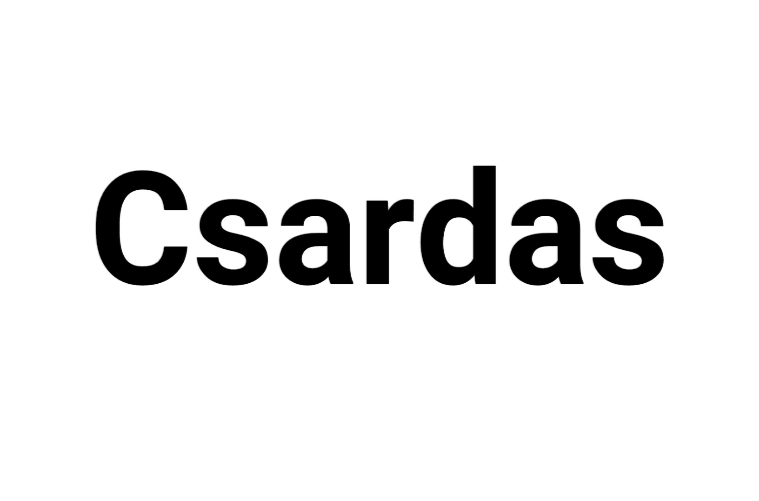Csárdás(或Czárdás)(匈牙利語: [tʃaːRDAːʃ] ,英文: /tʃɑrdæʃ /或//zɑrdəs)是一個傳統的匈牙利 民間舞蹈,從csárda(舊匈牙利長期派生的名稱酒館)。
起源在匈牙利和羅姆人(Cigány)音樂樂隊在匈牙利和鄰近的土地: 塞爾維亞,斯洛伐克 ,斯洛維尼亞,布爾根蘭州,克羅地亞,烏克蘭, 特蘭西瓦尼亞 和摩拉維亞,以及巴納特保加利亞之間推廣,包括保加利亞 。
基本介紹
- 中文名:Csardas
- 歌手:David Garrett
- 語種:暫無
- 所屬專輯:David Garrett (戴維·嘉雷特)
起源,提琴曲,引申-吉普賽人,
起源
Csárdás的起源可以追溯到18世紀匈牙利 verbunkos,作為招聘舞蹈由匈牙利軍隊使用 。
Csárdás是在變化的節奏特點:它開始慢慢( lassú)和在一個非常快節奏的結束( friss,字面意思是“新鮮”) 。有其他的節奏變化,被稱為ritka csárdás ,蘇茹 csárdás 和szökős csárdás 。音樂是在2 / 4或4 / 4 的時間 。
Csárdás (or Czárdás) (Hungarian: [ˈtʃaːrdaːʃ], English: /ˈtʃɑrdæʃ/ or /ˈzɑrdəs/) is a traditional Hungarian folk dance, the name derived from csárda (old Hungarian term for tavern). It originated in Hungary and was popularized by Roma music (Cigány) bands in Hungary and neighboring lands of Serbia, Slovakia, Slovenia, Burgenland, Croatia,Ukraine, Transylvania and Moravia, as well as among the Banat Bulgarians, including those in Bulgaria.[2]
The origin of the Csárdás can be traced back to the 18th century Hungarianverbunkos, used as a recruiting dance by the Hungarian army.
The Csárdás is characterized by a variation in tempo: it starts out slowly (lassú) and ends in a very fast tempo (friss, literally "fresh"). There are other tempo variations, called ritka csárdás, sűrű csárdás and szökős csárdás. The music is in2/4 or 4/4 time. The dancers are both male and female, with the women dressed in traditional wide skirts, usually colored red, which form a distinctive shape when they whirl.
Classical composers who have used csárdás themes in their works include Emmerich Kálmán, Franz Liszt, Johannes Brahms, Léo Delibes, Johann Strauss, Pablo de Sarasate, Pyotr Ilyich Tchaikovsky and others. The csárdás from Strauss' operettaDie Fledermaus, sung by the character Rosalinde, is probably the most famous example of this dance in vocal music. Probably the best-known instrumental csárdás is thecomposition by Vittorio Monti written for violin and piano. This virtuosic piece has 7 tempo variations. A recording of Monti's tune was made by Freddie Martin and His Orchestra (Whispering: Gene Conklin) in Holywood on November 6, 1948. It was released by RCA Victor Records as catalogue number 20-3123[3] and by EMI on the His Master's Voice label as catalogue number B 9716. The tune was arranged by Ballard.
1. Blatter, Alfred (2007). Revisiting music theory: a guide to the practice, p.28. ISBN 0415974402.
2. Kaufman, Nikolaj (2002). "Pesnite na banatskite bǎlgari" (in Bulgarian). Regionalni proučvanija na bǎlgarskija folklor. Tom 4. Severozapadna Bǎlgarija: obštnosti, tradicii, identičnost: p. 36. ISSN 0861-6558.
3. RCA Victor Records in the 20-3000 to 20-34999 series
提琴曲
Csardas (Gypsy Dance)
語種:暫無
所屬專輯:David Garrett (戴維·嘉雷特)
所屬唱片公司:暫無
審批文號:暫無
引申-吉普賽人
有一句古老的諺語說:“沒有吉卜賽人的地方就不算一個城鎮”。吉卜賽人是一個喜歡流浪的民族,從巴爾幹半島到阿爾卑斯山脈,從地中海沿岸到多瑙河畔,到處都有他們的足跡。他們的生活哲學是:“時間是用來流浪的,身軀是用來做愛的,生命是用來遺忘的。”——而他們的靈魂是用來唱歌的,他們坐著顛簸的大篷車,在一個又一個城鎮之間遊蕩,一把吉他,一管蛇笛,一隻用來給人占卜的水晶球,便是他們謀生的工具。他們在鬧市的街頭彈奏著樂曲,快樂地跳舞、唱歌,也不管路人到底投下幾個銅板。大約在19世紀初,流浪於匈牙利的吉卜賽人流行一種叫做“恰爾什達”(Csardas)的民間舞蹈,這種舞曲的藝術魅力曾經感染過李斯特、柏遼茲以及勃拉姆斯等歐洲浪漫主義音樂家。

